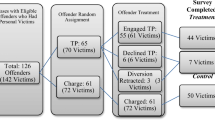Abstract
This article examines the satisfaction expressed by individuals complaining about anti-social behaviour to either the police, a local authority or a social housing provider in one English county in 2009/10. Based on a postal survey of 2251 anti-social behaviour (ASB) complainants, the study shows that just over half were satisfied with the outcome of their case. Logistic regression modelling using outcome satisfaction as the dependent variable found that reporting ASB to the police or local authority had no significant impact on outcome satisfaction, whereas reporting to a housing provider was associated with an increase in outcome satisfaction. The helpfulness of agency staff and keeping complainants informed of the progress of their case were found to be important in generating outcome satisfaction.
Similar content being viewed by others
Notes
It should be noted that most of these have not been specifically about the police response to ASB.
Ives (2007) has noted that those responding to postal surveys tend to report higher rates of ASB than those participating in a personal interview. This is not considered problematic in the current study as the sampling frame consisted only of those known to have reported ASB.
A goodness-of-fit test for weighted data of the full model for all reported incidents of ASB with all predictors against a constant-only model used an approach developed by Archer and Lemeshow (2006). This is interpreted like the Hosmer–Lemeshow test in that a statistically significant result indicates the model does not adequately fit the data. In this case, the model was not statistically significant and therefore did adequately fit the data. F-adjusted test statistic=F(9, 1957), P=0.655.
Goodness-of-fit F-adjusted test statistic=F(9, 602), P=0.507.
Goodness-of-fit F-adjusted test statistic=F(9, 520), P=0.908.
References
Archer, K.J. and Lemeshow, S. (2006) Goodness-of-fit test for a logistic regression model fitted using survey sample data. The Stata Journal 6 (1): 97–105.
Brown, A.P. (2004) Anti-social behaviour, crime control and social control. The Howard Journal 43 (2): 203–211.
Burney, E. (2009) Making People Behave: Anti-Social Behaviour, Politics and Policy, 2nd edn. Collumpton, UK: Willan Publishing.
Cohen, S. (1985) Visions of Social Control: Crime, Punishment and Classification. Cambridge: Polity.
Ekblom, P. and Heal, K. (1982) The Police Response to Calls from the Public. London: Home Office. Research and Planning Unit Paper no. 9.
Farrow, K. and Prior, D. (2006) Responding to anti-social behaviour: Reconciling top-down imperatives with bottom-up emotions. Community Safety Journal 5 (3): 20–28.
FitzGerald, M., Hough, M., Joseph, I. and Qureshi, T. (2002) Policing for London. Collumpton, UK: Willan Publishing.
Flint, J. (2013) Policing public housing: New York and British cities. Safer Communities Journal 12 (1): 13–23.
Hinds, L. and Murphy, K. (2007) Public satisfaction with police: Using procedural justice to improve police legitimacy. Australian and New Zealand Journal of Criminology 40 (1): 27–42.
Home Office (2003) Respect and Responsibility: Taking a Stand against Anti-Social Behaviour. London: Home Office.
Hough, M., Jackson, J., Bradford, B., Myhill, A. and Quinton, P. (2010) Procedural justice, trust and institutional legitimacy. Policing 4 (3): 203–210.
Hough, M. (2013) Procedural justice and professional policing in times of austerity. Criminology and Criminal Justice 13 (2): 181–197.
Innes, H. and Innes, M. (2013) Personal, Situational and Incidental Vulnerabilities to ASB Harm: A Follow Up Study. Cardiff, UK: Universities Police Science Institute, Cardiff University.
Ipsos MORI (2010) Policing Anti-Social Behaviour: The Public Perspective. London: Her Majesty’s Inspectorate of Constabulary.
Ives, G. (2007) Reporting anti-social behaviour. Community Safety Journal 6 (2): 39–43.
Jackson, J., Bradford, B., Hough, M., Myhill, A., Quinton, P. and Tyler, T. (2012) Why do people comply with the law? Legitimacy and the influence of legal institutions. British Journal of Criminology 52 (6): 1051–1071.
Jacobson, J., Millie, A. and Hough, M. (2005) Tackling Anti-Social Behaviour: A Critical Review. London: Institute for Criminal Policy Research.
Mackenzie, S., Bannister, J., Flint, J., Parr, S., Millie, A. and Fleetwood, J. (2010) The Drivers of Perceptions of Anti-Social Behaviour. London: Home Office. Home Office Research Report 34.
Mazerolle, L., Bennett, S., Davis, J., Sargeant, E. and Manning, M. (2013) Legitimacy in policing: A Systematic Review. Campbell Systematic Reviews, 2013:1.
Millie, A. (2009) Anti-Social Behaviour. Maidenhead, UK: Open University Press.
Murie, A. (1983) Housing Equality and Deprivation. London: Heinemann.
Murphy, K. (2009) Public satisfaction with the police: The importance of procedural justice and police performance in police-citizen encounters. Australian and New Zealand Journal of Criminology 42 (2): 159–178.
Singer, L. (2004) Reassurance Policing: An Evaluation of the Local Management of Community Safety. London: Home Office. Home Office Research Study no. 288.
Skogan, W. (1990) The Police and the Public in England and Wales: A British Crime Survey Report. London: Home Office. Home Office Research Study no. 117.
Skogan, W. (2005) Citizen satisfaction with police encounters. Police Quarterly 8 (3): 298–321.
Southgate, P. and Ekblom, P. (1984) Contacts between Police and Public: Findings from the British Crime Survey. London: Home Office. Home Office Research Study no. 77.
Thibaut, J. and Walker, L. (1975) Procedural Justice: A Psychological Analysis. Hillsdale, NJ: Lawrence Erlbaum.
Tyler, T.R. (1990) Why People Obey the Law. New Haven, CT: Yale University Press.
Upson, A. (2006) Perceptions and Experience of Anti-Social Behaviour: Findings from the 2004/05 British Crime Survey. London: Home Office. Home Office Online Report 21/06.
Author information
Authors and Affiliations
Corresponding author
Rights and permissions
About this article
Cite this article
Brown, R., Evans, E. Determinants of complainant satisfaction with agency responses to anti-social behaviour. Crime Prev Community Saf 16, 105–127 (2014). https://doi.org/10.1057/cpcs.2014.1
Published:
Issue Date:
DOI: https://doi.org/10.1057/cpcs.2014.1




